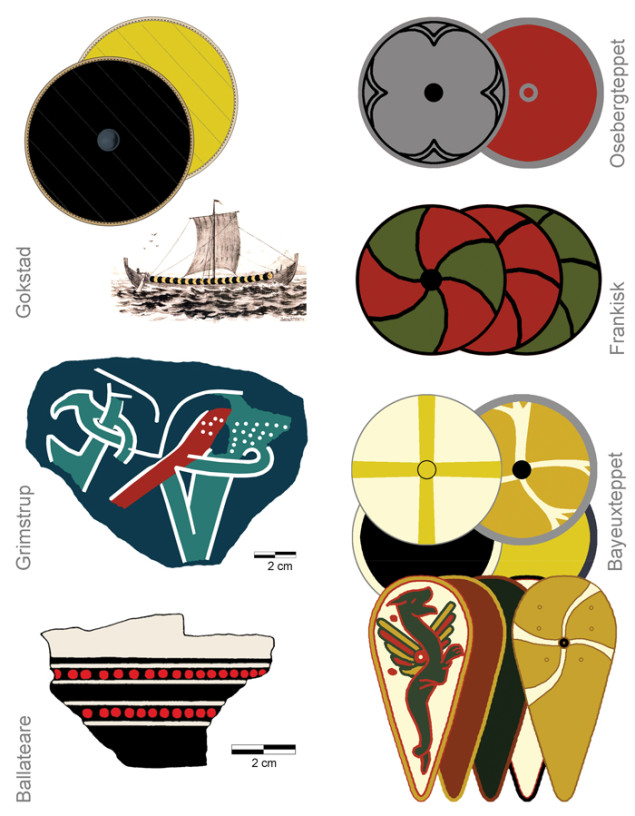Until now, we´ve believed the Gokstad chieftain´s colours as being black and yellow. New insight reveals that he more likely signalled his presence with white and red, and that the shields were made for decorative purposes only.
Text: Einar Chr. Erlingsen

This information appears in the newly presented doctoral thesis Viking Age Shields by Swedish archaeologist Kerstin Odebäck. (Vikingatida sköldar – Stockholm University 2021). Odebäck has amongst others worked with Norway´s Museum of Cultural History and Professor Jan Bill at the Viking Ship House in Oslo, where she was given access to the original objects as well as hitherto unpublished research material from the “Gokstad revitalised” project.
It is likely that Viking age chieftains and kings were identifying themselves through the use of colours. One example: The two upper boards of the ship belonging to the Ladby king in Denmark were painted in blue and yellow, respectively.
For almost 150 years, the Gokstad chieftain was believed to fly the colours yellow and black, the interpretation being the result of excavation leader Nicolay Nicolaysen´s 1880 visual observations. A number of more or less well-preserved shields or rather parts of shields were discovered at Gokstad.
Since Nicolaysen´s description from 1882 there has been now research on the shields, that is, until now, with the “Saving Oseberg laboratory” (connected to the conservation project for the Viking ships). Through the use of modern technologies, remnants of lead and iron were identified within the shields, pointing to colours red and white. When Nicolaysen “saw” black and yellow, it was the result of darkening after more than a thousand years underground.
Shields are rare. More or less well-preserved Viking shields are very rare, indeed. So Gokstad is our primary source to how these shields were constructed. No less than 439 large and small wooden fragments of shields were excavated, as well as 18 iron shield bucklers. Nicolaysen writes that the ship carried a total of 64 shields, information that cannot be confirmed today. However; we know that the ship carried 32 oars and equally many rowers.
(No shields were discovered at the nearby Oseberg mound. However, shields were depicted on remnants of the Oseberg tapestry. These shields are coloured grey and red).
The Gokstad shields are made from thin pieces of spruce, narrowing towards the edges. A large number of small holes along the edge points towards some kind of fitting, but since no remnants of metal has been identified, these might have been made from more perishable material like leather and sown onto the shield.
The diameter of the Gokstad shields is 94 cm. I the centre there is a circular hole for allowing space to the bearer´s hand, on protected on the outside by an iron shield buckler. No grip have been identified, these were perhaps made from more perishable wood than the shields themselves.
Recent research has revealed one more thing of interest: The “gripping holes” are probably too small to accommodate a powerful Viking hand. Thus, much points towards the shields having been made for decorative purposes only.
Shields for Saga Gokstad. At our Sandefjord worksite, Tore Forsberg and his crew of young and older volunteers have been busy for a while already with producing material for 64 shields to our Gokstad ship replica. Thanks to Kerstin Odbäck´s doctoral theses, now we also know how to paint them.
When we built sister ship Saga Oseberg, we produced 32 shields also for her. These were very popular amongst sponsor, thus contributing to the building of a replica of one of Norway´s proudest heritage objects. Soon we will start a similar sponsoring program for Saga Gokstad, each shield costing NOK 10.000, so please keep following us. (Or, if you´re ready to contribute straight away, contact einar@fmedia.no).
For more information (Norwegian only):

